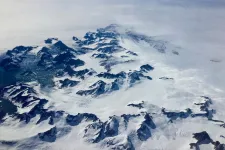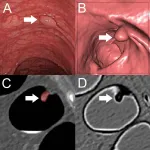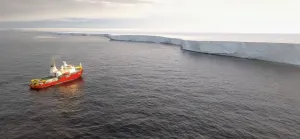'Problem of missing ice' finally solved by movement of the earth's crust
A new global ice sheet reconstruction for the past 80,000 years
2021-02-23
(Press-News.org) During ice ages, the global mean sea level falls because large amounts sea water are stored in the form of huge continental glaciers. Until now, mathematical models of the last ice age could not reconcile the height of the sea level and the thickness of the glacier masses: the so-called Missing Ice Problem. With new calculations that take into account crustal, gravitational and rotational perturbation of the solid Earth, an international team of climate researchers has succeeded in resolving the discrepancy, among them Dr. Paolo Stocchi from the Royal Netherlands Institute for Sea Research (NIOZ). The study, now published in the journal Nature Communications, could significantly advance research into the climate of the past and help to make better sea-level predictions for the future.
Paolo Stocchi: "Our new reconstruction revolutionizes what we thought about the global continental ice mass during the Last Ice Age. The total mass of the Last Ice Age glaciers was 20% smaller and accumulated faster than previously thought."
Growing and melting glaciers
With the alternation of ice ages and warm ages, the glaciers on Greenland, North America and Europe grow and shrink over the course of tens of thousands of years. The more water is stored in the form of ice, the less water there is in the oceans - and the lower the sea level. Climate researchers want to find out how much the glaciers could melt in the course of man-made climate change in the next centuries and how much the sea level will rise as a result. To do this, they look into the past. If one succeeds in understanding the growth and melting of the glaciers during the last ice and warm periods, then conclusions can be drawn for the future.
The "problem of the missing ice"
But this look into the past is difficult because the thickness of the glaciers and the height of the sea level can no longer be measured directly in retrospect. Climate researchers therefore have to laboriously collect clues that can be used to reconstruct the past. However, depending on which clues you collect, the results are different and seem to contradict one another. Previous models and calculations led to the so-called "missing ice" riddle. Geological evidence from ocean areas suggest that sea level might have been 120-140 m lower than today during the last Ice Age 20,000 years ago. The uncertainty of these data is quite large, though. To account for these low sea levels, as much as twice the current mass of the Greenland ice sheet would have to have been frozen worldwide. However, these glacier masses could not possibly have been that large at the time, according to climate models. Also, there is no geological evidence at higher latitudes for such a large mass of ice. How to explain then that the water wasn't in the sea and at the same time it wasn't stored in the freezer on land either?
80,000 years of ice sheets and sea level changes accurately reconstructed
This problem has now been solved with a new method by an international team of scientists led by Dr. Evan Gowan (Alfred-Wegener-Institut, Helmholtz-Zentrum für Polar- und Meeresforschung, in Bremerhaven). Among them the geophysicist Dr Paolo Stocchi from The Royal Netherlands Institute for Sea Research. "We have found a way to accurately reconstruct the last 80,000 years of ice sheets and sea level changes," says Dr. Paolo Stocchi, who has contributed to the creation of the novel global ice sheet model by including crustal, gravitational and rotational perturbation of the solid Earth. Their new model explains past local sea levels that are lower than today by incorporating the relative motion of the sea surface and Earth's crust. In this way, past local sea levels that are much lower than today, can be modelled without requiring an unrealistically large global ice mass. The solid Earth motions would do the trick!
Understanding the behavior of glaciers by looking at the Earth's mantle
With the new method, the scientists have eventually reconciled sea level and glacier mass: According to their calculations, the sea level must have been around 116 meters lower than today at the time. There is no discrepancy in terms of glacier mass. Unlike the previous global model, the team took a closer look at the geological conditions in the proximity and underneath the formerly glaciated areas, and not in the far-field ocean areas: How steep were the mountain slopes? Where did glaciers reach the sea? Did friction interfere with ice flow velocity? And how much? The new model includes all these local factors. It also accounts for ice- and water-load-induced crustal deformations. The latter are important because they alter the topography of the land, thus affecting the ice flow and eventually the volume of glaciers. "Crustal deformations are regulated by solid Earth physical parameters such as viscosity," says Paolo Stocchi. The Earth's mantle, in fact, behaves like a highly viscous fluid on geological time scales and deforms under the weight of a fluctuating ice mass. "By assuming different viscosities of the earth's mantle, we model different evolutions of the land topography, which then result in different scenarios for the ice masses." These can now be brought into harmony with the marine geological evidence from the ocean areas, without the need for extra mass.
The established isotope model needs to be revised
The technical article by Evan Gowan and his team takes a critical look at the method for estimating glacier masses that has been the standard in science for many years: the method of measuring oxygen isotopes. Isotopes are atoms of the same element that differ in the number of their neutrons and therefore have different weights. For example, there is the lighter 16O isotope and the heavier 18O isotope of oxygen. The theory says that the light 16O evaporates from the sea and the heavy 18O remains in the water. Accordingly, during ice ages, when large mainland glaciers form and the amount of water in the sea decreases, the 18O concentration in the oceans must increase. But as it turns out, this established method results in discrepancies when it comes to reconciling sea level and glacier mass for the time 20,000 years ago and before.
"The isotope model has been used widely for years to determine the volume of ice in glaciers up to many millions of years before our time. Our work now raises doubts about the reliability of this method," says Paolo Stocchi. His goal now is to use the new model to quantify the current rates of crustal deformation in the North Sea and Wadden Sea, thus revealing the actual contribution of current climate change to the regional relative sea-level changes.
INFORMATION:
[Attachments] See images for this press release:

ELSE PRESS RELEASES FROM THIS DATE:
2021-02-23
During this unique study, a team of researchers led by Professor Jane Ogden from the University of Surrey investigated the impact of actively preparing or watching others prepare food (e.g., on a cooking show) versus distraction away from this focus. Researchers sought to understand how this may affect the amount of food consumed and influence the desire to continue eating.
To investigate this further, eighty female participants were recruited and assigned to one of four groups: active food preparation (preparing a cheese wrap within 10 minutes), video food preparation (watching a video of a researcher preparing a cheese wrap), distraction ...
2021-02-23
University of Alberta researchers have found that limiting the amount of fat the body releases into the bloodstream from fat cells during heart failure could help improve outcomes for patients.
In a recent study published in the American Journal of Physiology, Jason Dyck, professor of pediatrics in the Faculty of Medicine & Dentistry and director of the U of A's Cardiovascular Research Centre, found that mice with heart failure that were treated with a drug blocking the release of fat into the bloodstream from fat cells saw less inflammation in the heart and throughout the body, and had better outcomes than a control group.
"Many people believe that, by definition, heart failure is only ...
2021-02-23
New Orleans, LA - An LSU Health New Orleans School of Public Health study reports a positive association between social vulnerability and COVID-19 incidence at the census tract level and recommends that more resources be allocated to socially vulnerable populations to reduce the incidence of COVID-19. The findings are published in Frontiers in Public Health, available END ...
2021-02-23
Gay men are more likely than lesbian women to face stigma and avoidant prejudice from their heterosexual peers due to the sound of their voice, a new study in the British Journal of Social Psychology reports. Researchers also found that gay men who believe they sound gay anticipate stigma and are more vigilant regarding the reactions of others.
During this unique study researchers from the University of Surrey investigated the role of essentialist beliefs -- the view that every person has a set of attributes that provide an insight into their identity -- of heterosexual, lesbian ...
2021-02-23
In Wonderland, Alice drank a potion to shrink herself. In nature, some animal species shrink to escape the attention of human hunters, a process that takes from decades to millennia. To begin to understand the genetics of shrinking, scientists working at the Smithsonian Tropical Research Institute (STRI) in Panama successfully extracted DNA from marine shells. Their new technique will not only shed light on how animals from lizards to lemurs shrink, it will reveal many other stories hidden in shells.
"Humans are unique as predators," said Alexis Sullivan, doctoral student at Penn ...
2021-02-23
OAK BROOK, Ill. - A machine learning algorithm helps accurately differentiate benign and premalignant colorectal polyps on CT colonography scans, according to a study published in the journal Radiology.
Colorectal cancer is among the three most common causes of cancer-related death among men and women in industrialized countries. Most types of colorectal cancer originate from adenomatous polyps--gland-like growths on the mucous membrane lining the large intestine--that develop over several years. Early detection and removal of these precancerous polyps can reduce the incidence and mortality of colorectal cancer.
During the last two decades, CT colonography emerged as a noninvasive ...
2021-02-23
Peer review/observational study/people
In patients with severe COVID-19, the innate immune system overreacts. This overreaction may underlie the formation of blood clots (thrombi) and deterioration in oxygen saturation that affect the patients. This is shown in an Uppsala University study published in the journal Frontiers in Immunology.
Blood contains numerous proteins that constitute the body's primary barrier, by both recognising and destroying microorganisms, including SARS-CoV-2 (the virus that causes COVID-19). These proteins are part of the intravascular innate immune system (IIIS), which consists of certain white blood cells, platelets and what are known as the cascade systems of the blood.
Only 5 ...
2021-02-23
Glaciers in West Antarctica are moving more quickly from land into the ocean, contributing to rising global sea levels. A 25-year record of satellite observations has been used to show widespread increases in ice speed across the Getz sector for the first time, with some ice accelerating into the ocean by nearly 50%.
The new study, led by the University of Leeds, reports that 14 glaciers in the Getz region are thinning and flowing more quickly into the ocean. Between 1994 and 2018, 315 gigatonnes of ice has been lost, adding 0.9 mm to global mean sea level - equivalent to 126 million Olympic swimming pools of water.
The results published today (19/02/2021) in the journal Nature Communications show that, on average, ...
2021-02-23
A radiotherapy technique which 'paints' tumours by targeting them precisely, and avoiding healthy tissue, has been devised in research led by the University of Strathclyde.
Researchers used a magnetic lens to focus a Very High Electron Energy (VHEE) beam to a zone of a few millimetres. Concentrating the radiation into a small volume of high dose will enable it to be rapidly scanned across a tumour, while controlling its intensity.
It is being proposed as an alternative to other forms of radiotherapy, which can risk non-tumorous tissue becoming overexposed to radiation.
The researchers are planning further investigation, with the use of a purpose-built device.
The study ...
2021-02-23
During glacial periods, the sea level falls, because vast quantities of water are stored in the massive inland glaciers. To date, however, computer models have been unable to reconcile sea-level height with the thickness of the glaciers. Using innovative new calculations, a team of climate researchers led by the Alfred Wegener Institute has now managed to explain this discrepancy. The study, which was recently published in the journal Nature Communications, could significantly advance research into our planet's climate history.
During transitions from glacials to interglacials, the glaciers on Greenland and in North America and Europe wax and wane ...
LAST 30 PRESS RELEASES:
[Press-News.org] 'Problem of missing ice' finally solved by movement of the earth's crust
A new global ice sheet reconstruction for the past 80,000 years



